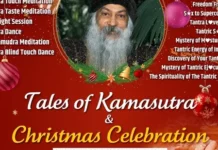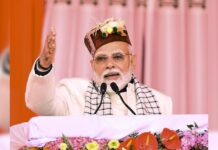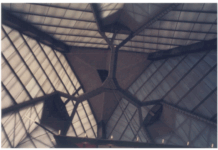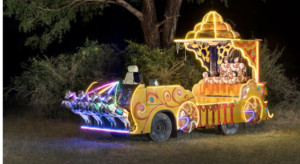 The vehicle of choice for gods, demons, and mortals alike, the ratha or chariot has had a pivotal place in Indian mythology and folklore. They are equally associated with tales of righteous elopement by couples denied the right to be together as with dastardly abduction of brides by rakshasas.
The vehicle of choice for gods, demons, and mortals alike, the ratha or chariot has had a pivotal place in Indian mythology and folklore. They are equally associated with tales of righteous elopement by couples denied the right to be together as with dastardly abduction of brides by rakshasas.
India has a tradition of mobile architecture going back centuries, with its divine associations. The chariot’s use in public processions seeks to elevate the human activity presented to a mythic status. Consequently, the chariot’s close association with wedding rituals should come as no surprise. Their raised platform allows the bride and the groom to be placed on a pedestal, offering revelers a chance to get close to them.
Much has changed since the horse-drawn chariots of yore. Contemporary wedding processions across the country mostly feature sleek vintage cars. Which is what made it really exciting to encounter a vehicle that was a curious juxtaposition of the medieval and postmodern in the Thiruvannamalai district of Tamil Nadu. Not a chariot, not quite a car either – these curious vehicles are used to drive the bride and the groom through the streets of their town as a public announcement of their betrothal.
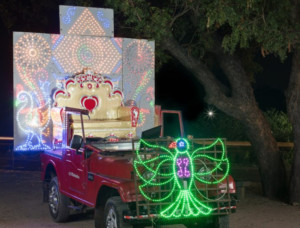 A relatively recent addition to the local wedding industry, automobile chariots have been popularized in the past couple of decades. Prior to their advent, wedding processions were conducted on foot or using bicycle driven carts. Sensing an opportunity, enterprising wedding decorators introduced these vehicles targeting upwardly mobile families. Since their popularization in the wedding industry, political parties have also realized their potential, using them as campaign vehicles.
A relatively recent addition to the local wedding industry, automobile chariots have been popularized in the past couple of decades. Prior to their advent, wedding processions were conducted on foot or using bicycle driven carts. Sensing an opportunity, enterprising wedding decorators introduced these vehicles targeting upwardly mobile families. Since their popularization in the wedding industry, political parties have also realized their potential, using them as campaign vehicles.
An embodiment of Indian jugaad, these vehicles are spectacles of low-cost innovation. Fabricated using stock cars, the rear seat is completely removed to accommodate an elevated platform on which a sofa or chairs are placed for the bride and the groom. This platform has an ornate background referred to locally as a ‘disco’ which is made of papier-mâché decoration around a fiber board housing LED or tungsten bulbs. The lighting is powered by a generator tucked away in the trunk of the car.
Vedic Hindu wedding rites dictate that the moment the bride mounts the groom’s chariot marks the transition from her childhood home to her married life after which the groom ‘takes charge’ of her. In Thiruvannamalai, traditionally, on the day of their wedding, the bride and groom’s families meet at a pre-designated temple for a ritual, followed by a procession to the wedding venue.
The vehicles are photographed at night to accentuate its most unique feature –the ‘disco’. Considering they are usually observed in crowded
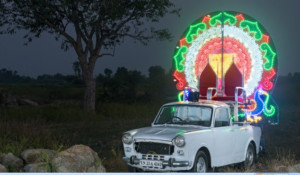
processions, I consciously presented these cars devoid of human presence in order to depart from the way Indian weddings are usually represented. The images are a tranquil remnant of the chaotic celebrations that the vehicles facilitated.
Sameer Raichur
Courtesy sameer-raichur.com
Sameer Raichur (b.1986) is an independent photographer based out of Bangalore, India. He graduated with distinction from the Hallmark Institute of Photography; Turners Falls, MA in 2012. He draws inspiration from the diversity of culture and landscape between urban and rural India.



